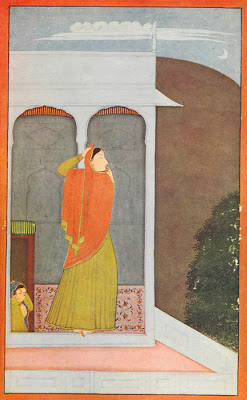The style of the Rajput paintings is an archaic, unsophisticated style. The figures mostly appear according to the principle of “perfect visibility,” which is contrary to any attempt at giving the illusion of a third dimension: the heads are shown in profile, but with the visible eye in full length, the chest is displayed in full expanse and the gestures are confined to the front plane. The background is, comparatively, simple; buildings as well as landscape settings have often to serve a linear system of surface organization reminiscent, in a fashion, of the compartmental sectioning of the Gujurati miniatures. But the figures with their striking gestures and expressive attitude convey a feeling of tremendous energy and the background is penetrated by their own emotional atmosphere.
Emmy
Wellesz, Akbar’s Religious Thought Reflected
In Mogul Painting, London, George Allen
and Unwin Ltd, 1952.
Upper: THE EXPECTANT HEROINE. Kangra school, early
nineteenth century. Painting on paper. Lady Rothenstein collection.
Lower: VAIKUNTHA, THE HEAVEN OF VISHNU. Rajasthani school, about 1750. Painting on Paper. Lady Rothenstein collection.




Yes, Curtis. Many thanks for this.
ReplyDeleteKangra and Bilaspur (that is where I have lived all my life, almost)were the one of the main places where the Kangra School of Miniature Paintings initially flourished.
I was thinking of you. I've been beset lately with a lot of business sturm und drang, brouhaha, etc., which I'm about to dive back into. Thanks for providing the lovely interval to respond. Curtis
ReplyDelete